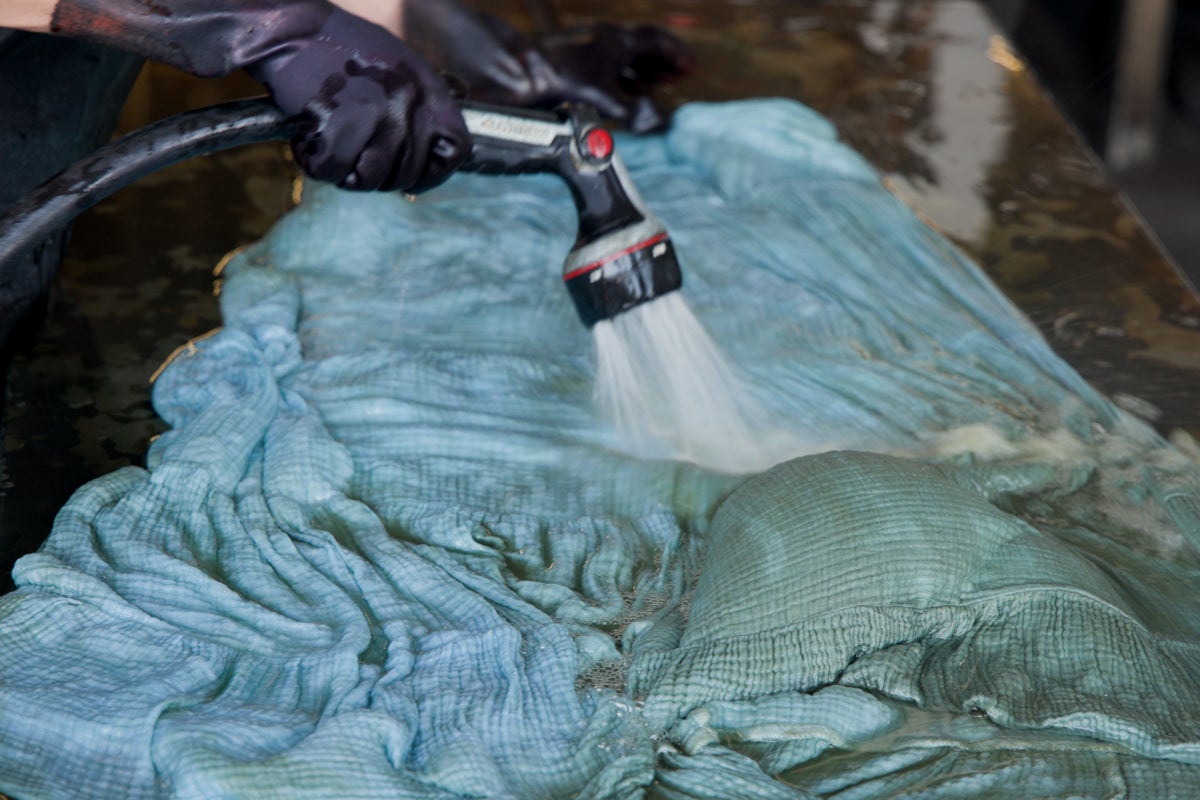Climate Fixers: Slowing down ‘fast fashion’ with natural dyes
Synthetic dyes are often petroleum-based and pollute waterways. At a former dairy farm in Lancaster County, Pa., flowers, plants and kitchen waste color clothes naturally.
This story is part of the WHYY News Climate Desk, bringing you news and solutions for our changing region.
From the Poconos to the Jersey Shore to the mouth of the Delaware Bay, what do you want to know about climate change? What would you like us to cover? Get in touch.
When Winona Quigley left Lancaster County as a teenager to study fashion at the Parsons School of Design in Manhattan, she dreamed of a glamorous life working in the New York City fashion industry.
“And as I was starting my career, that was when the Rana Plaza collapse happened. That happened in Bangladesh in 2013,” Quigley said. More than 1,100 garment workers were killed in a factory near Dhaka. Thousands more were injured in what is considered one of the world’s worst industrial accidents.
“And that was a factory that was producing [garments] for a lot of big brands that we recognize as American consumers,” Quigley said. “And it was completely preventable, and it was the lack of regulation that caused it to happen. And I think it was a big wake-up call for everybody in fashion that the people who are making our clothes are not being compensated enough, they don’t have the safety they need, and there was just not a lot of thought going into how our clothing is being made.”
Asking questions about the human toll of the fashion industry evolved into questions about the environmental impact of clothing manufacturing. It led Quigley back to her roots, where she now runs a natural dye company in Lancaster County.
“Aside from the pollution generated by the fashion industry, the majority of garments that Americans wear are produced in several different countries and have a large carbon footprint because they’re being shipped all over the world to be manufactured,” said Quigley. “Yarns might be spun in one country but knit into fabric in another country. And so the amount of shipping that a single T-shirt can have really adds up.”

Another influence kicked in for Quigley. Her grandmother, who helped raise her in Lancaster County, worked as a garment worker and taught her how to sew.
“She was forced into retirement when that factory closed in the 1980s as more, not just textile, but sewing factories, every component of garment making was being sent overseas,” Quigley said.
Today, Quigley operates Green Matters Natural Dye Company out of a former cattle barn in Gap, Pennsylvania.
Standing next to a giant vat of blue dye made from indigo, Quigley used a paddle to turn a garment in the dye mix. When she lifted it out of the tub, it looked green until it was hosed down with water, and you could see the transformation to the blue we associate with denim.

She explained how synthetic dyes, which use chemicals to create different colors and are often made from fossil fuels, lead to pollution.
“The real issue is that the majority of garments and fabrics that American consumers are wearing or using in their homes are produced in countries with little regulation about where those synthetic dyes can be dumped, and it is often having a big impact on local ecosystems as factories dump trillions of gallons [of dye], usually into rivers that have an impact on the agriculture downstream, and also has an impact on the garment workers working in the factories using those dyes.”
For a bright yellow, Quigley uses marigolds, which can also make shades of green. Madder root has been used for centuries to make deep reds, pinks or oranges. She also uses pomegranate peels to make yellow and green, and garden flowers like dahlias or cosmos can create a bunch of different colors from deep oranges to grays.
Some dye ingredients can be foraged from a compost bin.
“We also work with food waste like avocado pits, which can make a really lovely pale pink,” Quigley said.

Green Matters works with Chipotle Mexican Grill to dye the company’s merchandise using leftover avocado pits from the restaurants’ kitchen.
In terms of lowering the overall carbon footprint of the fashion industry, Quigley said keeping all aspects of clothing production right here in the U.S. cuts emissions associated with transportation.
“We’re doing commercial dyeing for fashion brands, and a lot of our clients are producing entirely in the U.S. That means they’re buying American made cotton that’s made in American mills, that’s sewn in American factories and the garments are dyed here in the United States.”
Green Matters Dye Company also has a retail side, where individual customers can send in garments to be dyed. They can always choose indigo, or each month, the company features three separate color options.
“So what that means is that rather than a garment that is stained or faded or a color that we consider to be out of season, that person is able to reduce the carbon impact that they have by keeping their existing garments in their wardrobe, rather than continuing to buy new,” Quigley said.

It’s part of a larger movement to “slow down” fashion in order to combat the growing waste of mass produced “fast fashion” that has taken off in the last several decades. Consumers may be able to buy the latest trends at rock bottom prices but at high costs to the environment and to low-wage workers.
“I think it’s really important for consumers to think about the longevity of the garments they already own and get acquainted with the people in their community that can help them, like a local tailor, altering garments to fit you or repairing garments that need a new zipper, or have a hole in them,” Quigley said. “Or working with a dyer to change the color of a garment.”
She urges people interested in cutting their carbon footprint to think of their wardrobe as a long-term investment.
“We’re trying to be a part of the slow fashion movement, the opposite of fast fashion, where, yes, you are keeping something for 25 years, or even keeping something for five or 10 years would be a big jump for a lot of American consumers.”

Get daily updates from WHYY News!
WHYY is your source for fact-based, in-depth journalism and information. As a nonprofit organization, we rely on financial support from readers like you. Please give today.






